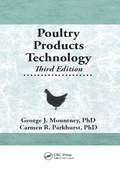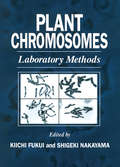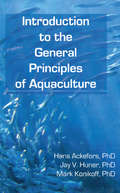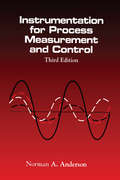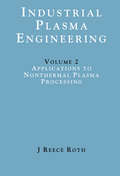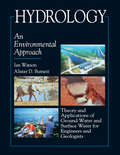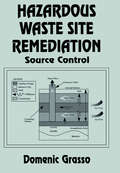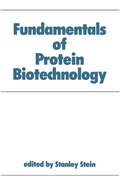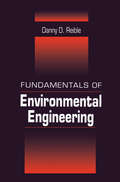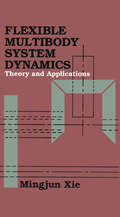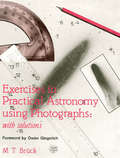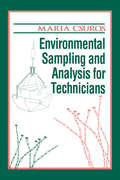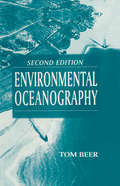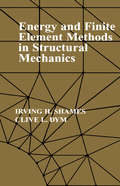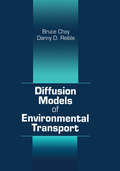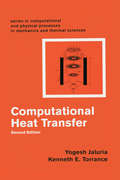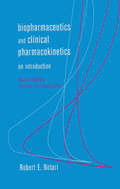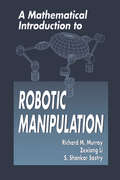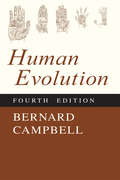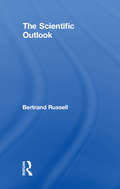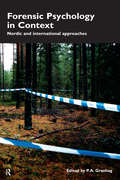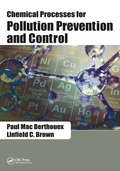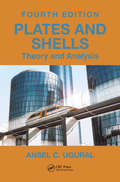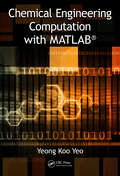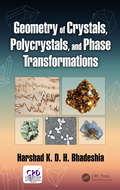- Table View
- List View
Poultry Products Technology: Third Edition
by VivianE MountneyNow in its third edition, this classic volume characterizes the science and technology of the poultry industry today, defines the breadth and scope of the overall problems in the industry, and points out areas where more research is needed. With special attention to recent changes in the industry, the nearly two dozen updated chapters of Poultry Products Technology provide a comprehensive overview of the field, examining topics which deal with the processing, handling, marketing, and preparation of poultry meat, products, and by-products.Poultry Products Technology provides up-to-date information and references for food scientists, food technologists, dieticians, and others trained in the food service industry, who will at some point handle poultry products. This book supplies knowledge about how poultry and eggs are processed and prepared and how they can be used for optimum portions and services. The breadth of topics covered, as listed below, make it an ideal text for those just entering the field, for individuals who wish to learn about the work in a particular area before starting extensive research, and for those in the industry who require specific information for making decisions and projecting plans for the future:quality identification--grades and standardsquality maintenance--handling and processing poultry and eggs to prevent grade losseschemical and nutritive characteristics of poultry meat and eggsmicrobiology of eggs and poultry meatmethods of preservation--freezing, drying, refrigeration, radiation, canning, smokingcooking poultry meat and eggshandling and uses of inedible by-productsmethods of analysis of eggs and egg productsDuring the last twenty years, the consumption of poultry meat has and continues to increase while the consumption of eggs has steadily decreased, yet both are still considered good econ
Plant Chromosomes: Laboratory Methods
by Kiichi Fukui Shigeki NakayamaFinally - a guide to cytological techniques written specifically for the plant chromosome researcher and student. Plant Chromosomes: Laboratory Methods thoroughly covers all important approaches to the study of plant chromosomes. It reviews each specific approach and describes requisite experimental techniques. These practical descriptions cover basic, standard techniques as well as the most recent research advances and state-of-the-art technologies. Plant Chromosomes: Laboratory Methods allows you to build on the knowledge of its expert authors, who have first-hand experience with the ins and outs of each approach. Through hundreds of trouble-shooting suggestions it also helps you avoid experimental pitfalls by providing invaluable tips at critical points in the experimental process. This book gives you the information you need to improve the power of your plant chromosome research - saving you time and effort in the process. No other single volume contains so much practical information on this topic.
Introduction to the General Principles of Aquaculture
by Mark KonikoffIntroduction to the General Principles of Aquaculture provides novice aquaculturists with an overview of the aquaculture industry so you may proceed successfully in academic studies or commercial ventures. The authors furnish you with insight into the history and development of aquaculture and cover the subjects of natural production versus aquaculture, the aquatic environment, energy requirements of and relationships in aquaculture systems, important components of aquaculture systems, selection of aquaculture species, major cultured species and their distribution, global aquaculture production, a comparison of agriculture and aquaculture, and those factors promoting and constraining aquaculture. The book is liberally illustrated so that students and laymen are able to visualize systems and species. Furthermore, tables and figures are used throughout to emphasize important points, facts, and methods. As an introductory text, it emphasizes several aspects of aquaculture that must be understood by those new to the industry. These aspects include water quality, species of importance around the world, and current and projected aquaculture production on a global basis. The important components of any aquaculture system are also covered in some detail--biological factors, technical-biological factors, technical-economic factors, production cost factors, socioeconomic factors, and species selection factors.Laypersons considering aquaculture as an investment and students considering aquaculture as a career, but who have no real background in agriculture and fisheries sciences,will find this book to be a key information source. Introduction to the General Principles of Aquaculture is written with the global market in mind and instructors will find it to be a useful introductory text at the undergraduate level. Persons in advisory capacities such as County Extension Agents, extension service specialists and bureaucrats in various arms of government who hav
Instrumentation for Process Measurement and Control, Third Editon
by Norman A. AndersonThe perennially bestselling third edition of Norman A. Anderson's Instrumentation for Process Measurement and Control provides an outstanding and practical reference for both students and practitioners. It introduces the fields of process measurement and feedback control and bridges the gap between basic technology and more sophisticated systems. Keeping mathematics to a minimum, the material meets the needs of the instrumentation engineer or technician who must learn how equipment operates. I t covers pneumatic and electronic control systems, actuators and valves, control loop adjustment, combination control systems, and process computers and simulation
Industrial Plasma Engineering: Volume 2 - Applications to Nonthermal Plasma Processing
by J Reece RothWritten by a leading expert in the field, the paperback edition of Industrial Plasma Engineering, Volume 2: Applications to Nonthermal Plasma Processing provides a background in the principles and applications of low temperature, partially ionized Lorentzian plasmas that are used industrially. The book also presents a description of plasma-related processes and devices that are of commercial interest. The text is suitable for students or in-service users with a physics and calculus background at the sophomore level. These two volumes are intended to be used as textbooks at the senior or first-year graduate level by students from all engineering and physical science disciplines and as a reference source by in-service engineers.
Hydrology: An Environmental Approach
by Ian WatsonHydrology covers the fundamentals of hydrology and hydrogeology, taking an environmental slant dictated by the emphasis in recent times for the remediation of contaminated aquifers and surface-water bodies as well as a demand for new designs that impose the least negative impact on the natural environment. Major topics covered include hydrological principles, groundwater flow, groundwater contamination and clean-up, groundwater applications to civil engineering, well hydraulics, and surface water. Additional topics addressed include flood analysis, flood control, and both ground-water and surface-water applications to civil engineering design.
Hazardous Waste Site Remediation
by Domenic GrassoHazardous Waste Site Remediation is an outstanding textbook that reviews specific treatment processes, as well as pertinent basic concepts in organic geochemistry, material balance mass transfer, thermodynamics, and kinetics. Following a quantitative approach to source control, the text covers regulations, materials handling, engineering principles, soil vapor extraction, chemical extraction and soil washing, solidification and stabilization, and chemical destruction. It also explores topics in bioremediation, thermal processes, risk assessment, and waste minimization. A solutions manual is available.
Fundamentals of Protein Biotechnology
by SteinFills a gap between the existing studies of proteins, which tend to be highly technical and geared toward the practicing protein chemist, and biochemistry textbooks, which focus on general principles. Scientists cover a dozen topics by presenting fundamental principles, an overview, and the practica
Fundamentals of Environmental Engineering
by Danny ReibleThe field of environmental engineering is rapidly emerging into a mainstream engineering discipline. For a long time, environmental engineering has suffered from the lack of a well-defined identity. At times, the problems faced by environmental engineers require knowledge in many engineering fields, including chemical, civil, sanitary, and mechanical engineering. Increased demand for undergraduate training in environmental engineering has led to growth in the number of undergraduate programs offered. Fundamentals of Environmental Engineering provides an introductory approach that focuses on the basics of this growing field.This informative reference provides an introduction to environmental pollutants, basic engineering principles, dimensional analysis, physical chemistry, mass, and energy and component balances. It also explains the applications of these ideas to the understanding of key problems in air, water, and soil pollution.
Flexible Multibody System Dynamics: Theory And Applications
by Mingjun XieThis volume examines the theoretical and practical needs on the subject of multibody system dynamics with emphasis on flexible systems and engineering applications. lt focuses on developing an all purpose algorithm for the dynamic simulation of flexible tree-like systems making use of matrix representation at all levels. The book covers new theories with engineering applications involved in broad fields which include; civil engineering, aerospace and robotics, as well as general and mechanical engineering. The applications include high temperature conditions, time variant contact conditions, biosystem analysis, vibration minimization and control.
Exercises in Practical Astronomy: Using Photographs
by M. T BuckOffering a series of well-defined problems supplemented by solutions, Exercises in Practical Astronomy: Using Photographs presents meaningful practical work in elementary astronomy and astrophysics. The book provides authentic astronomical photographs of very high quality on which different types of objects can be studied with equipment as simple as rulers and protractors. In addition to photographs and a set of exercises that cover 12 topics, the coverage includes ample hints and worked solutions that are designed to enable students to work independently. SI units are used for physical data and in conversions of astronomical quantities. This book is one of the few to use real rather than idealized or simplified data in the problems.
Environmental Sampling and Analysis for Technicians
by Maria CsurosThis book provides the basic knowledge in sample collection, field and laboratory quality assurance/quality control (QA/QC), sample custody, regulations and standards of environmental pollutants. The text covers sample collection, preservation, handling, detailed field activities, and sample custody. It provides an overview of the occurrence, source, and fate of toxic pollutants, as well as their control by regulations and standards. Environmental Sampling and Analysis for Technicians is an excellent introductory text for laboratory training classes, namely those teaching inorganic nonmetals, metals, and trace organic pollutants and their detection in environmental samples.
Environmental Oceanography (CRC Marine Science #11)
by Tom BeerThe second edition of Environmental Oceanography is the first textbook to link the needs of the coastal oceanographer and the environmental practitioner. The ever-increasing human impact on the environment, and particularly on the coastal zone, has led governments to carefully examine the environmental implications of development proposals. This book provides the background needed to undertake coastal oceanographic investigations and sets them in context by incorporating case studies and sample problems based on the author's experience as an environmental consultant.
Energy and Finite Element Methods In Structural Mechanics: SI Units
by IrvingH ShamesFirst published in 1996. CRC Press is an imprint of Taylor & Francis.
Diffusion Models of Environmental Transport
by Danny D. Reible Bruce ChoyFate and transport models are critical components in the determination of the exposure to and risk from hazardous contaminants. Analytical models are preferable because they are generally more accessible, more reliable, and require fewer computational resources. Surprisingly, until today, only a limited number of analytical models have been accessible in the literature.Now, there is Diffusion Models of Environmental Transport, which provides more than 40 analytical models of diffusion and advective-diffusion in one, two, and three layer systems, subject to a wide range of boundary and initial conditions. This text illustrates applications to contaminant transport in sediments and soils, including porewater and vapor transport, and also provides Mathcad spreadsheets to aid in the use of these models.The authors supply complete details of the solutions to the models for those who wish for a deeper understanding. For others, who do not have the time or the need, the solutions themselves are ready to be picked up and used. Reible and Choy use their 20-plus years of cumulative experience to create a thorough exploration of fate and transport models. This comprehensive text furnishes an invaluable reference for students and environmental professionals.
Computational Heat Transfer
by Yogesh JaluriaThis new edition updated the material by expanding coverage of certain topics, adding new examples and problems, removing outdated material, and adding a computer disk, which will be included with each book. Professor Jaluria and Torrance have structured a text addressing both finite difference and finite element methods, comparing a number of applicable methods.
Biopharmaceutics and Clinical Pharmacokinetics: An Introduction, Fourth Edition
by Robert E. NotariFor a decade and a half, Biopharmaceutics and Clinical Pharmacokinetics has been used in theclassrooms around the world as an introductory textbook on biophannaceutics and phannacokinetics. Now, the new Fourth Edition, Revised and Expanded further enhances the preceding editions'proven features, introducing significant advances in clinical pharmacokinetics, pharmacokineticdesign of drugs and dosage forms, and model-independent analyses. Still usable without prior knowledge of calculus or kinetics, this successfully implemented workbookmaintains a carefully graduated "building block" presentation, incorporating sample problemsand exercises throughout for a thorough understanding of the material.Biopharmaceutics and Clinical Pharmacokinetics features a growth-oriented format that systematicallydevelops and interrelates all subject matter .. . introduces basic theory and fields of application... emphasizes model-independent pharmacokinetic analyses ... presents biopharmaceutical aspectsof product design and evaluation .. . offers a unique approach to teaching dosage regimen design andindividualization . .. and considers structural modification of drug molecules for problems associatedwith pharmacokinetics. As a comprehensive coverage of the basic principles and the recent achievements in the field, noother textbook does as much for students of pharmacy, pharmacology, medicinal chemistry, andmedicine, or for scientists who desire a simple but thorough introduction to theory and application.
A Mathematical Introduction to Robotic Manipulation
by Richard M. Murray Zexiang Li S. Shankar SastryA Mathematical Introduction to Robotic Manipulation presents a mathematical formulation of the kinematics, dynamics, and control of robot manipulators. It uses an elegant set of mathematical tools that emphasizes the geometry of robot motion and allows a large class of robotic manipulation problems to be analyzed within a unified framework. The foundation of the book is a derivation of robot kinematics using the product of the exponentials formula. The authors explore the kinematics of open-chain manipulators and multifingered robot hands, present an analysis of the dynamics and control of robot systems, discuss the specification and control of internal forces and internal motions, and address the implications of the nonholonomic nature of rolling contact are addressed, as well. The wealth of information, numerous examples, and exercises make A Mathematical Introduction to Robotic Manipulation valuable as both a reference for robotics researchers and a text for students in advanced robotics courses.
Human Evolution: An Introduction to Man's Adaptations
by Bernard CampbellIn this new fourth edition, Campbell has revised and updated his classic introduction to the field. Human Evolution synthesizes the major findings of modern research and theory and presents a complete and integrated account of the evolution of human beings. New developments in microbiology and recent fossil records are incorporated into the enormous range of this volume, with the resulting text as lucid and comprehensive as earlier editions. The fourth edition retains the thematic structure and organization of the third, with its cogent treatment of human variability and speciation, primate locomotion, and nonverbal communication and the evolution of language, supported by more than 150 detailed illustrations and an expanded and updated glossary and bibliography. As in prior editions, the book treats evolution as a concomitant development of the main behavioral and functional complexes of the genus Homo– among them motor control and locomotion, mastication and digestion, the senses and reproduction. It analyzes each complex in terms of its changing function, and continually stresses how the separate complexes evolve interdependently over the long course of the human journey. All these aspects are placed within the context of contemporary evolutionary and genetic theory, analyses of the varied extensions of the fossil record, and contemporary primatology and comparative morphology. The result is a primary text for undergraduate and graduate courses, one that will also serve as required reading for anthropologists, biologists, and nonspecialists with an interest in human evolution.
The Scientific Outlook
by Bertrand Russell'A scientific opinion is one which there is some reason to believe is true; an unscientific opinion is one which is held for some reason other than its probable truth.' - Bertrand RussellOne of Russell's most important books, this early classic on science illuminates his thinking on the promise and threat of scientific progress. Russell considers three questions fundamental to an understanding of science: the nature and scope of scientific knowledge, the increased power over nature that science affords, and the changes in the lives of human beings that result from new forms of science. With customary wit and clarity, Russell offers brilliant discussions of many major scientific figures, including Aristotle, Galileo, Newton and Darwin.With a new introduciton by David Papineau, King's College, London.
Forensic Psychology in Context: Nordic and International Approaches
by P. A. GranhagAcademics and researchers from the Nordic countries (Sweden, Iceland, Norway, Finland) have made a particularly strong contribution internationally to the rapidly developing disciplines of forensic and legal psychology. This book brings together the leading authorities in the field to look systematically at the central issues and concerns of their subject, looking at both investigative psychology and psychology in court. Forensic Psychology in Context reflects the results of research in the Nordic countries themselves, but each chapter situates this work within a broader comparative and international context. The book is a major contribution to the subject, and will be essential reading for anybody with interests in this field.
Chemical Processes for Pollution Prevention and Control
by Paul Mac Berthouex Linfield C. BrownThis book examines how chemistry, chemical processes, and transformations are used for pollution prevention and control. Pollution prevention reduces or eliminates pollution at the source, whereas pollution control involves destroying, reducing, or managing pollutants that cannot be eliminated at the source. Applications of environmental chemistry are further illustrated by nearly 150 figures, numerous example calculations, and several case studies designed to develop analytical and problem solving skills. The book presents a variety of practical applications and is unique in its integration of pollution prevention and control, as well as air, water, and solid waste management.
Plates and Shells: Theory and Analysis, Fourth Edition (Applied and Computational Mechanics)
by Ansel C. UguralNoted for its practical, accessible approach to senior and graduate-level engineering mechanics, Plates and Shells: Theory and Analysis is a long-time bestselling text on the subjects of elasticity and stress analysis. Many new examples and applications are included to review and support key foundational concepts. Advanced methods are discussed and analyzed, accompanied by illustrations. Problems are carefully arranged from the basic to the more challenging level. Computer/numerical approaches (Finite Difference, Finite Element, MATLAB) are introduced, and MATLAB code for selected illustrative problems and a case study is included.
Chemical Engineering Computation with MATLAB®
by Yeong Koo YeoMost problems encountered in chemical engineering are sophisticated and interdisciplinary. Thus, it is important for today’s engineering students, researchers, and professionals to be proficient in the use of software tools for problem solving. MATLAB® is one such tool that is distinguished by the ability to perform calculations in vector-matrix form, a large library of built-in functions, strong structural language, and a rich set of graphical visualization tools. Furthermore, MATLAB integrates computations, visualization and programming in an intuitive, user-friendly environment. Chemical Engineering Computation with MATLAB® presents basic to advanced levels of problem-solving techniques using MATLAB as the computation environment. The book provides examples and problems extracted from core chemical engineering subject areas and presents a basic instruction in the use of MATLAB for problem solving. It provides many examples and exercises and extensive problem-solving instruction and solutions for various problems. Solutions are developed using fundamental principles to construct mathematical models and an equation-oriented approach is used to generate numerical results. A wealth of examples demonstrate the implementation of various problem-solving approaches and methodologies for problem formulation, problem solving, analysis, and presentation, as well as visualization and documentation of results. This book also provides aid with advanced problems that are often encountered in graduate research and industrial operations, such as nonlinear regression, parameter estimation in differential systems, two-point boundary value problems and partial differential equations and optimization.
Geometry of Crystals, Polycrystals, and Phase Transformations
by Harshad K. BhadeshiaOrganized into a two-part structure aimed at readers of differing experience levels, Geometry of Crystals, Polycrystals, and Phase Transformations is accessible to both newcomers and advanced researchers within the field of crystallography. The first part of the text covers what any reader in the material sciences, physics, chemistry, earth sciences and natural sciences in general should know about crystallography. It is intentionally concise and covers sufficient material to form a firm foundation. The second part is aimed at researchers and discusses phase transformations, deformations, and interface crystallography in depth. The phase transformations are limited to those dominated by crystallography. The entire book contains worked examples and uniquely deals not just with crystals but aggregates of crystals and solid-state transformations between crystals.
